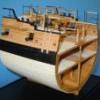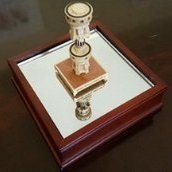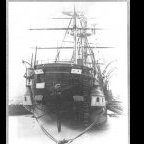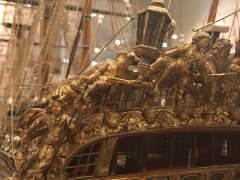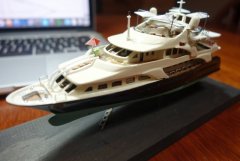Supplies of the Ship Modeler's Handbook are running out. Get your copy NOW before they are gone! Click on photo to order.
×
-
Posts
2,420 -
Joined
-
Last visited
Reputation Activity
-
 dvm27 got a reaction from Nirvana in Altair 1931 by KeithAug - FINISHED - Scale 1:32 - schooner
dvm27 got a reaction from Nirvana in Altair 1931 by KeithAug - FINISHED - Scale 1:32 - schooner
Been very close to step 4, Keith! Definitely optional.
-
 dvm27 reacted to michael mott in Albertic by michael mott - FINISHED - Scale 1:100 - RESTORATION - Bassett-Lowke Model
dvm27 reacted to michael mott in Albertic by michael mott - FINISHED - Scale 1:100 - RESTORATION - Bassett-Lowke Model
Well thank you all for your encouraging comments and kind remarks.
Now that i am back working on the stuff that keep me up at night trying to figure out the next move, I have assembled the new davit and think it will be OK when hidden among the rest.
The next up in the line of the other davits that have been straightened out. The new davit is the one closest.
Michael
-
 dvm27 reacted to KeithAug in Altair 1931 by KeithAug - FINISHED - Scale 1:32 - schooner
dvm27 reacted to KeithAug in Altair 1931 by KeithAug - FINISHED - Scale 1:32 - schooner
Greg,
My lathe also has backlash - I have never worked on one that doesn't. All I do is make sure that the settings are always made when winding the dials in one direction - clockwise is normal. If I need to move the slide or saddle in the opposite direction I just wind the dial further than I need to go and then wind it back to the setting in the clockwise direction. This was the way I was taught to do it when I was an apprentice 50 years ago and it works well. The fitting of digital scales eliminates the problem and can be done quite cheaply these days.
Bill,
The best way to avoid the problem of cut off pieces flying across the workshop is as follows.
1. Advance the slitting saw into the component to make the cut.
2. As you come to the end of the cut slow down the rate of feed of the saw into the workpiece (best done using manual feed).
3. Just before the part comes away from the parent metal it will begin to rise away. This is because the web retaining it has insufficient strength to resist the pushing force of the saw.
4. At this point stop the saw, and use your fingers to pull the part free. If you are making lots of parts remember always to stop the saw - you would be surprised how tempting it can be to chance it.
The sketch may help:-
-
 dvm27 got a reaction from mtaylor in Altair 1931 by KeithAug - FINISHED - Scale 1:32 - schooner
dvm27 got a reaction from mtaylor in Altair 1931 by KeithAug - FINISHED - Scale 1:32 - schooner
Beautiful work, Keith. It seems like backlash is a problem for me when I try to do repeated sequences such as you have done above. I found an article by Sherline on how to adjust for it and I shall have to read it.
-
 dvm27 reacted to Dan Vadas in Concord Stagecoach by Dan Vadas - FINISHED - Model Trailways - 1:12 scale - circa 1862 "Cobb & Co"
dvm27 reacted to Dan Vadas in Concord Stagecoach by Dan Vadas - FINISHED - Model Trailways - 1:12 scale - circa 1862 "Cobb & Co"
Hi all,
I'm finally back after a long layoff due to Cancer treatment, not something I'd recommend but it beats passing away. All seems to be OK now .
Those of you who remember me (those of you who don't - check my Signature for past Builds) may recall that I had a Model Shipways (Trailways) kit of a Concord Stagecoach which I'd intended to build for one of my grandsons. The time has finally arrived where I feel up to the task.
Here are the "obligatory" pics of the box and it's contents :
Quality of the parts and especially the instructions seems to be of a high standard. Here's a small start to the project, cutting the tenons for the Reaches - the longitudinal members of the chassis :
More will follow soon.
Cheers, Danny
-
 dvm27 reacted to GAW in Falls of Clyde 1878 by GAW - FINISHED - scale 1:96 - iron 40-frame hull center cross-section
dvm27 reacted to GAW in Falls of Clyde 1878 by GAW - FINISHED - scale 1:96 - iron 40-frame hull center cross-section
Fig- 68 - A brass angle, provided with the required rivet heads is soft soldered to the out side edge of the main deck stringer plating, this being soldered to the tops of the main deck beams. The vertical portion of the angle is then soldered to the top plate of the hull plating called the Sheerstrake, but not at the top, but a double row of rived heads below the top. The Sheerstrake plating connects - by rivets on the full size hull - each of the frames, to the main deck beams, via the Stringer Plates, and also to the Bulwarks above, hence the two rows of rivet heads above the Stringer Plate and angle. On a riveted hull such as this, there are IN plates and OUT plates. The Sheerstrake is an IN plate, meaning that it is riveted directly to the frames. The one below and the Bulwarks above being OUT plates. More on this later.
-

-
 dvm27 reacted to michael mott in Altair 1931 by KeithAug - FINISHED - Scale 1:32 - schooner
dvm27 reacted to michael mott in Altair 1931 by KeithAug - FINISHED - Scale 1:32 - schooner
Greg I had the same problem with the backlash on the big mill drill, it is why i fitted the dial verniers backlash is no longer an issue because the dial does not move until the carriage moves so the information about the position of the table/vise is always the same when you follow the dials.
Michael
-
 dvm27 got a reaction from KeithAug in Altair 1931 by KeithAug - FINISHED - Scale 1:32 - schooner
dvm27 got a reaction from KeithAug in Altair 1931 by KeithAug - FINISHED - Scale 1:32 - schooner
Beautiful work, Keith. It seems like backlash is a problem for me when I try to do repeated sequences such as you have done above. I found an article by Sherline on how to adjust for it and I shall have to read it.
-
 dvm27 reacted to KeithAug in Altair 1931 by KeithAug - FINISHED - Scale 1:32 - schooner
dvm27 reacted to KeithAug in Altair 1931 by KeithAug - FINISHED - Scale 1:32 - schooner
Thank you Michael and welcome to all other visitors.
After a bit of time away I got back to finishing the cleats - now all done. In the end I decided to simplify the construction by eliminating the stem tube spacer - see earlier post.
I used a simple jig to make sure that the pins went in at right angles to the top. The pins were glued in place using CA.
The feet were attached to the deck first. The hold down bolts are from a spectacle repair kit - hundreds of very small size screws for a few pounds - ebay. I drilled a thin sheet of steel to create a template for drilling the deck.
The central holes in the foot were drilled through to the deck to take the tops.
A few more shots of the deck:-
Having completed the cleats I made the 4 secondary winches. As I think I said previously these are omitted in error from the plans but are very clear on web based photographs / videos. The winches are .325 max diameter x .300 high.
-
 dvm27 got a reaction from Keith Black in Miniature Russian carving tools
dvm27 got a reaction from Keith Black in Miniature Russian carving tools
My set is in the mail and I'm looking forward to receiving them! Michael writes that he has a few left.
-
 dvm27 got a reaction from daHeld73 in Yet Another Pandora 3D build
dvm27 got a reaction from daHeld73 in Yet Another Pandora 3D build
That's really cool Dennis. It would be even cooler if you were to use a contemporary Admiralty dockyard building slip, complete with workers, as the background.
-
 dvm27 got a reaction from BETAQDAVE in Miniature Russian carving tools
dvm27 got a reaction from BETAQDAVE in Miniature Russian carving tools
My set is in the mail and I'm looking forward to receiving them! Michael writes that he has a few left.
-

-
 dvm27 reacted to EdT in Young America 1853 by EdT - FINISHED - extreme clipper
dvm27 reacted to EdT in Young America 1853 by EdT - FINISHED - extreme clipper
Young America - extreme clipper 1853
Part 205 – Making Lower Shrouds
Before getting into making shrouds, I completed one more chore that has been on my mind for a while. The brass poop rail was becoming more tarnished by the day, so considering that it was losing its shiny appeal and that the original was probably iron, I decided to paint the rail white. See the first picture.
I decided on white based on the photo taken at San Francisco. After degreasing with acetone, the rail was painted with gloss white enamel – two coats, slightly thinned.
The lower fore shrouds shown in the following pictures are 10½" rope, laid up from three strands of Barbour Irish linen thread. An adequate discussion of rope making, cotton vs. linen, and size matching is beyond the scope of this log, but I have been working on a description for Volume III. My rope making "machinery" and process has undergone major development since my first efforts 20+ years ago – but is, of course, still not perfect. For dimensional reasons and the difficulty in making good four-strand rope without a central core, the shrouds are three-strand, even though four-strand was typically used for these. They are also right-handed, in keeping with American practice at the time.
Shrouds were made in pairs that were looped over the mast head, starting with the forward starboard pair, followed by that pair on the port side and continuing in that way. In the first picture, the third starboard pair has been cut to length, looped over the mast and is being marked at the ends of its served length – at the futtocks - with a white pencil.
The shroud was then removed and transferred to the serving machine as shown in the next picture.
Before putting tension on the rope, needles were inserted through the rope at the white marks so serving thread could be pulled through to help secure each end. Starting at the right, after pulling the thread through, the rope was then served, initially over the thread end, then up to the second needle which was threaded and pulled through to complete the joint at the second end. In the next picture, an earlier served shroud has been looped over the mast and is being marked at what will be the top of the seizing to show the extent of the outer parceling that was used as an added protection against damp in the closely packed bights.
With the shroud stretched between two vises, white PVA glue was applied and the shroud wrapped with strips of tissue, working from each end toward the center as shown below.
The white PVA dries softer than Titebond making it easier to loop the shrouds later. After wrapping, the shroud was looped over the mast until the glue dried. The parceling was then painted with artist's acrylic paint. After the first coat dried, the seizing was put on as shown below.
The last picture shows both gangs of shrouds looped over the fore mast head.
An alligator clip is holding the final pair while the parceling glue dries. After seizing and painting this pair, the shrouds will be ready for the deadeyes at the lower ends to be turned in.
Ed
-

-
 dvm27 reacted to Mahuna in Kathryn by Mahuna - FINISHED - 1:32 - Skipjack Based on HAER Drawings
dvm27 reacted to Mahuna in Kathryn by Mahuna - FINISHED - 1:32 - Skipjack Based on HAER Drawings
Part 10 – Frames, cont’d
The installation of frames 2 through 26 followed the process outlined in the previous posts. The following photos show Kathryn with those frames installed.
Close inspection shows that some of the frames are out of alignment by as much as 1/16”, likely as a result of some slight errors in their construction or in the installation. In most models this can be adjusted by fairing the frames prior to planking. However, Kathryn’s frames are delicate, and I’m not comfortable with the idea of fairing them through sanding.
In checking the frames by holding a ribband against them, I observed that the frames are fairly flexible and move in the required direction fairly easily. Since the first planking and/or timbers to be installed will be in Kathryn’s interior, I decided to temporarily install ribbands on the outside of the hull. I used 1/16” x 1/8” poplar ribbands, and attached them to the hull by wiring them to some of the frames using 34 gauge wire.
The following photos show Kathryn with the ribbands installed.
These ribbands were installed prior to the installion of frame 1, so that frame 1 could be properly aligned with the flow of the ribbands.
The installation of frame 1 did not depend on the drawing of the frame, as in the other frame installations. Instead, the installation jig was lined up with the construction plan drawing and adjusted for the placement of the mortise. The frame was then installed against this jig and using the ribband for positioning, as in the following photos.
The clothes pins used as clamps in the above photos are miniature clothes pins - this illustrates the small size of the frames.
The installation of frames 1 through 26 is now completed. There is one last frame (frame 'A') that will be mortised into the stem knee, but this will be completed after the installation of the knightheads to ensure a smooth flow of planking at the bow.
The following photos show the model with frames 1-26 completed.
The next task will be the installation of the stern timbers that support the transom. This will be my first attempt at this type of installation, and I still have quite a few questions about how to proceed. In the next post (and probably several after that) I will try to explain the open questions that I have, in the hopes that I can get some answers/direction from the more experienced modelers who are following Kathryn’s progress. I hope to be able to start this dialogue by early next week.
Thanks everyone!
-
 dvm27 got a reaction from Hubac's Historian in SS Michelangelo 1962 by shipmodel - FINISHED - 1/350 scale
dvm27 got a reaction from Hubac's Historian in SS Michelangelo 1962 by shipmodel - FINISHED - 1/350 scale
Really enjoying this build, Dan. I really admire those who can build ships of any era with equal excellence.
Great link, Keith! Don't believe I've come across micro brass tubing that small before.
-
 dvm27 got a reaction from druxey in SS Michelangelo 1962 by shipmodel - FINISHED - 1/350 scale
dvm27 got a reaction from druxey in SS Michelangelo 1962 by shipmodel - FINISHED - 1/350 scale
Really enjoying this build, Dan. I really admire those who can build ships of any era with equal excellence.
Great link, Keith! Don't believe I've come across micro brass tubing that small before.
-

-
 dvm27 got a reaction from Canute in SS Michelangelo 1962 by shipmodel - FINISHED - 1/350 scale
dvm27 got a reaction from Canute in SS Michelangelo 1962 by shipmodel - FINISHED - 1/350 scale
Really enjoying this build, Dan. I really admire those who can build ships of any era with equal excellence.
Great link, Keith! Don't believe I've come across micro brass tubing that small before.
-
 dvm27 got a reaction from KeithAug in SS Michelangelo 1962 by shipmodel - FINISHED - 1/350 scale
dvm27 got a reaction from KeithAug in SS Michelangelo 1962 by shipmodel - FINISHED - 1/350 scale
Really enjoying this build, Dan. I really admire those who can build ships of any era with equal excellence.
Great link, Keith! Don't believe I've come across micro brass tubing that small before.
-
 dvm27 got a reaction from Omega1234 in SS Michelangelo 1962 by shipmodel - FINISHED - 1/350 scale
dvm27 got a reaction from Omega1234 in SS Michelangelo 1962 by shipmodel - FINISHED - 1/350 scale
Really enjoying this build, Dan. I really admire those who can build ships of any era with equal excellence.
Great link, Keith! Don't believe I've come across micro brass tubing that small before.
-
 dvm27 reacted to giampieroricci in L'Amarante 1749 by giampieroricci - FINISHED - 1:30 - French Corvette
dvm27 reacted to giampieroricci in L'Amarante 1749 by giampieroricci - FINISHED - 1:30 - French Corvette
I also ended the little boat; I have to pass only a coat of matte varnish
-
 dvm27 reacted to Bluto 1790 in HMS Leopard 1790 by Bluto - FINISHED - 1:80 - 50 gun ship - PoB
dvm27 reacted to Bluto 1790 in HMS Leopard 1790 by Bluto - FINISHED - 1:80 - 50 gun ship - PoB
All channels and stools for main and mizzen masts now fitted . . . and hammock cranes & netting for Q/deck rail and port side of poop deck also fitted. Just port side of waist and forecastle await their hammock cranes . . . then it will soon be time to be thinking about the scary rigging for real.


